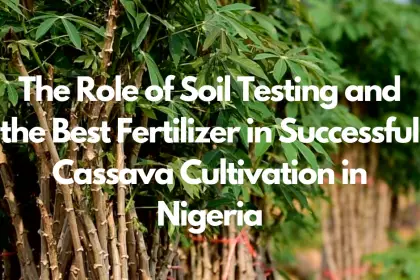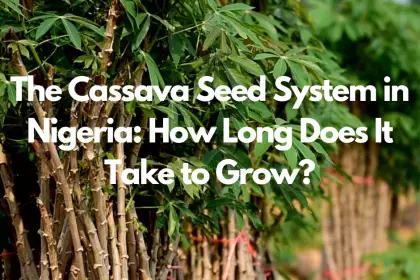In the realm of agriculture, cassava production stands as a significant component of food security and economic stability, especially in regions like Nigeria where it is a staple crop. The adoption of digital technology in cassava farming in Nigeria has ushered in a transformative period, enabling more efficient cultivation methods and bolstering overall output. This evolution highlights the crucial role technology plays in modernizing agricultural practices and meeting the demands of an ever-growing population.
As the article unfolds, it will examine the pivotal digital tools revolutionizing cassava farming in Nigeria, from data analytics to precision agriculture, and their impact on yield and productivity. It will also tackle the challenges inherent in adopting these technologies and propose best practices for seamless integration. Looking forward, the discussion will aim to sketch a future where digital technology continues to be a driving force in enhancing cassava production, ensuring sustainability, and fostering growth in the agricultural sector.
The Evolution of Cassava Farming
Tracing the roots of cassava farming unveils a journey spanning approximately 10,000 years, beginning in South America before making its way across continents through the hands of Spanish and Portuguese explorers in the 16th century. This historical voyage marked the introduction of cassava to Africa and Asia, where it adapted remarkably well to diverse climates and soil conditions. In Africa, particularly, cassava established itself as a staple crop, thriving in poor soil and drought conditions, a testament to its resilience and adaptability.
- Traditional vs. Modern Farming Techniques:
-
- Traditional Methods: Involves planting cuttings in mounds or ridges to enhance soil drainage and aeration.
- Modernization Efforts: Adoption of mechanization, irrigation, and genetically improved seed varieties aimed at increasing efficiency and yield.
The evolution of cassava farming is also marked by significant advancements in biotechnology and breeding programs. These efforts have been directed towards:
- Reducing Post-Harvest Losses: Innovative technologies have been developed to tackle the challenge of post-harvest losses, which can reach up to 50%.
- Genetic Modification and Breeding: Utilization of biotechnology to enhance resistance to pests and diseases, and breeding programs focusing on yield, nutritional content, and pest resistance improvements.
Cassava’s role in Nigeria’s economy is particularly noteworthy, with the country standing as the world’s largest producer. The crop’s introduction during the slave trade era and its eventual rise as a staple food highlight its economic and cultural significance. Government initiatives aimed at promoting cassava production underscore its importance in achieving self-sufficiency and reducing reliance on imported grains.
Key Digital Tools in Cassava Farming
In the dynamic world of cassava production, the integration of digital tools has significantly enhanced efficiency and productivity. Among these innovations, Near-Infrared Spectroscopy (NIRS) stands out for its precision in quantifying carotenoids and distinguishing cassava roots based on cyanogenic potential. This method not only offers high prediction accuracy but also serves as an efficient, objective assessment tool.
- Digital Tools Transforming Cassava Farming:
-
- NIRS Technology: Enables accurate quantification of carotenoids and identification of cassava roots with varying cyanogenic potentials.
- IITA Herbicide Calculator: A mobile app aiding farmers in calculating the correct quantity of herbicides, thus ensuring economic and environmental safety.
- Cassava Seed Tracker: A web-app facilitating access to quality seed production and improved cassava varieties from accredited seed producers.
- Cassava e-Market: An online marketplace that connects farmers with buyers, promoting efficient selling of cassava and related commodities.
Furthermore, the integration of the Internet of Things (IoT) into the cassava supply chain streamlines operations from farm to market, ensuring traceability and efficiency. This digital evolution, including innovations like AKILIMO, a comprehensive digital advisory service, and small processing machines tailored for women farmers, marks a significant leap towards modernizing cassava farming in Nigeria. These advancements not only cater to the immediate needs of farmers but also pave the way for a sustainable, technologically driven future in cassava production.
Impact on Yield and Productivity
The integration of digital technology in cassava production has notably impacted yield and productivity, leveraging genetic resources and molecular markers to enhance the crop’s characteristics.
- Genetic Enhancements and Molecular Markers:
-
- Thousands of simple sequence repeats (SSR) markers, a comprehensive cassava chromosome-scale reference genome, and a haplotype map featuring 25.9 million SNPs and 19 million indels have revolutionized cassava breeding.
- Molecular markers facilitate the assessment of accession uniqueness, adoption rates, cross-validation, and guide in parental selection, ensuring the cultivation of superior cassava varieties.
- Phenotyping for Improved Breeding:
-
- Advanced phenotyping techniques are employed to evaluate breeding lines and germplasm collections, focusing on nutrition, yield, quality, biotic stresses, and root system architecture. Precise phenotyping is crucial for characterizing genetic factors that contribute to phenotypic variation, leading to the development of cassava varieties with enhanced disease resistance and higher yield potential.
- Impact on Farmers’ Revenue and Productivity:
-
- A study in Kogi State, Nigeria, highlighted that 79.33% of farmers adopted improved cassava varieties, resulting in an average revenue increase of N27,750 post-adoption. Moreover, initiatives like the Six Steps to Cassava Weed Management and Best Planting Practices toolkit have enabled farmers to double their yield to more than 20 tons per hectare, significantly above the national average of 9 tons per hectare. Additionally, ICT tools, including mobile phones, have positively influenced rural agricultural productivity, altering crop choices and selling prices.
These advancements underscore the transformative role of digital technology in enhancing cassava production, promising a future of increased efficiency, sustainability, and profitability in the sector.
Challenges in Adopting New Technologies
Adopting new technologies in cassava production faces various challenges that hinder the seamless integration and optimization of these advancements in Nigeria. These challenges, as identified by respondents and studies, can be broadly categorized into policy, infrastructure, financial, and technical constraints.
- Policy and Infrastructure Challenges:
-
- Inconsistent Agricultural Policy Framework: 71.7% of respondents identify this as a significant barrier, emphasizing the need for stable policies to support cassava processing.
- Infrastructure Deficits: Highlighted by 74.01% of respondents, poor infrastructure, including roads and electricity, severely impacts cassava processing efficiency.
- Mechanization Levels: With 73.6% acknowledgment, the lack of advanced machinery limits processing capabilities and food production.
- Financial and Technical Constraints:
-
- Access to Capital: A major hurdle for 74.71% of respondents, indicating that financial support is crucial for adopting new technologies.
- Technical Expertise: The absence of skilled agricultural technical experts, as agreed by 72.85% of respondents, and high costs associated with equipment purchase and maintenance impede technological adoption.
- Socio-Cultural and Educational Barriers:
-
- Cultural Beliefs and Education: Hidden mechanisms like cultural beliefs and the level of education among farmers influence the adoption of new technologies. This is further compounded by limited access to agricultural extension services and stringent credit facilities.
These challenges underscore the complexity of integrating digital technology into cassava production in Nigeria, necessitating a multifaceted approach to address these barriers effectively.
Best Practices for Integration
To ensure the successful integration of digital technology in cassava production, the following best practices are recommended:
- Infrastructure and Social Amenities Improvement:
-
- Upgrade road infrastructure to facilitate easier access to markets.
- Provide modern farm cultivation and processing equipment to enhance efficiency.
- Improve social amenities to make rural farming communities more self-sustaining.
- Innovative Processing Techniques:
-
- Implement new drying techniques and fermentation technologies to make cassava processing more efficient and less time-consuming.
- Encourage the adoption of technology-driven solutions like precision agriculture and pest and disease monitoring systems.
- Sustainable Farming Practices:
-
- Promote the use of sustainable farming practices to improve soil health and reduce environmental impact.
- Focus on capacity building for farmers to increase their knowledge and skills in modern farming techniques and sustainable practices.
These strategies aim to make cassava farming more productive and sustainable, leveraging digital technology to enhance yield and efficiency while minimizing environmental impact.
The Future of Cassava Farming with Digital Technology
The transformative journey of cassava production, propelled by the advent of digital technologies, underscores the vast potential of modern agricultural practices in Nigeria. From the historical progression of traditional farming methods to the integration of cutting-edge digital tools, the narrative of cassava farming is one of significant evolution and promise. These advancements, including precision agriculture and various digital applications, have not only improved yield and productivity but have also positioned cassava farming as a beacon of economic stability and food security in the region. However, this transformation does not come without its challenges, from infrastructural deficits to financial constraints, underscoring the need for a concerted effort to address these barriers.
As we look to the future, it is evident that digital technology will continue to play an indispensable role in the cultivation and distribution of cassava. The implications of this shift extend beyond mere agricultural productivity, touching on aspects of sustainability, farmer livelihoods, and the broader economy. To harness the full potential of this digital revolution, it is crucial to prioritize infrastructural improvements, access to financial resources, and the education of farming communities in modern agricultural practices. By doing so, cassava production in Nigeria can achieve new heights of efficiency and innovation, ensuring food security and economic vitality for years to come.
FAQs
1. What influences cassava crop yields?
Cassava yields are affected by a variety of specific factors related to individual farms. These include the size of the land, whether the farm has livestock, the farmer’s experience, and if there are other agricultural activities being conducted on the farm. Additionally, the ability to access markets plays a significant role in the farmer’s ability to sell cassava products effectively.
2. How much cassava is currently produced in Nigeria?
Nigeria faces the ongoing issue of low cassava yields. Presently, the country produces approximately 60 million tonnes of cassava from around 6.5 million hectares, which results in an average yield of 9.1 tonnes per hectare. This figure is considerably lower when compared to Ghana, which has an average yield of 20 tonnes per hectare, and Indonesia, with 24 tonnes per hectare.
3. How technically efficient is cassava farming?
The technical efficiency of cassava farming varies, with a range between 0.334 and 0.972 and an average of 0.790. This indicates that, on average, cassava farmers are able to achieve about 80% of the potential output from their inputs.
4. What challenges do cassava producers face in Nigeria?
The primary challenges for cassava production in Nigeria include the agricultural policy framework, the level of farm mechanization, infrastructure, the availability of agricultural technical experts, and farmers’ access to capital. These factors significantly impact the efficiency and productivity of cassava processing in the country.











